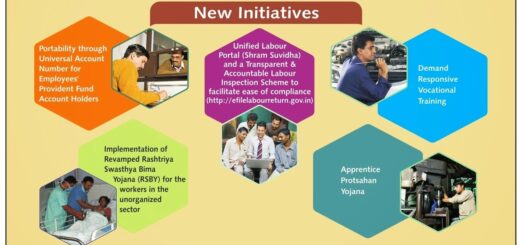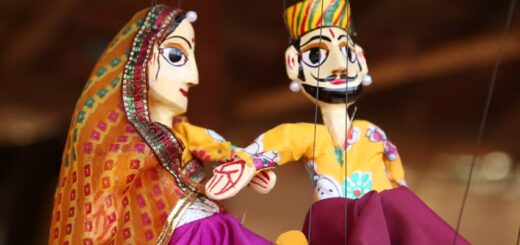Ministry of Finance Scheme – Article
1. Pradhan Mantri Mudra Yojana
MUDRA stands for Micro Units Development and Refinance Agency
Objective:
- The core objective of the bank is to fund the unfunded. It will finance to “Last Mile Financiers” of small/micro businesses. The lending priority will be given to SC/ST enterprises
- MUDRA Bank will be set up as a statutory body
- It will regulate and refinance all MFI who lend to MSME engaged in small manufacturing, trade or services.
- It will partner all state/regional level coordinators to provide easy finance to even the remote investors.
- MUDRA Bank has rightly classified the borrowers into three segments:
- To address the three segments, MUDRA Bank has launched three loan instruments:
- Shishu: covers loans upto Rs 50,000/-
- Kishor: covers loans above Rs 50,000/- and upto Rs. 5 lakh
- Tarun: covers loans above Rs 5 lakh and upto Rs 10 lakh
- It provides a loan at low rates to small entrepreneurs
- The bank has been allotted a Refinance Fund of Rs. 20,000 Crores from the shortfalls of Priority Sector Lending.
2. Pradhan Mantri Jan Dhan Yojana
- All households across the country – both rural and urban are to be covered under the scheme. Bank accounts will be opened for 15 crore poor persons.
- All bank accounts opened under the scheme are to have an overdraft facility of Rs 5,000 for Aadhar-linked accounts after satisfactory operation in the account for 6 months.
- Issuance of RuPay Debit Card with inbuilt Rs 1 lakh personal accident insurance cover provided by HDFC Ergo and a life cover of Rs 30,000 provided by LIC
- A minimum monthly remuneration of Rs 5,000 to business correspondents who will provide the last link between the account holders and the bank.
- Rupay Debit Card is an indigenous domestic debit card introduced by National Payment Corporation of India (NPCI). This card is accepted at all ATMs (for cash withdrawal) and at most of the PoS machines (for making cashless payment for purchases) in the country.
3. Pradhan Mantri Suraksha Bima Yojana (PMSBY) (Scheme 1 – for Accidental Death Insurance)
- Eligibility: Available to people in age group 18 to 70 years with bank account.
- Premium: Rs.12 per annum.
- Payment Mode: The premium will be directly auto-debited by the bank from the subscribers account on or before 1 st June of each annual coverage period under the scheme.
Risk Coverage
- Death – Rs 2 Lakh
- Total and irrecoverable loss of both eyes or loss of use of both hands or feet or loss of sight of one eye and loss of use of hand or foot – Rs 2 Lakh
- Total and irrecoverable loss of sight of one eye or loss of use of one hand or foot – Rs.1 Lakh.
- Eligibility : Any person having a bank account and Aadhaar number linked to the bank account can give a simple form to the bank every year before 1st of June in order to join the scheme. Name of nominee to be given in the form.
- The scheme will be offered by all Public Sector General Insurance Companies and all other insurers who are willing to join the scheme and tie-up with banks for this purpose.
Government Contribution:
- Various Ministries can co-contribute premium for various categories of their beneficiaries from their budget or from Public Welfare Fund created in this budget from unclaimed money. This will be decided separately during the year.
- Common Publicity Expenditure will be borne by the Government.
4. The Pradhan Mantri Jeevan Jyoti Bima Yojana (PMJJBY – Scheme 2 – for Life Insurance Cover)
- Eligibility : Available to people in the age group of 18 to 50 and having a bank account. People who join the scheme before completing 50 years can, however, continue to have the risk of life cover up to the age of 55 years subject to payment of premium.
- Premium : Rs.330 per annum. It will be auto-debited in one installment
- Risk Coverage :2 Lakh in case of death for any reason.
(Other terms are same as accidental cover )
5. National Health Protection Mission
National Health Protection Mission is a part of Ayushman Bharat yojana which has two major health sector initiatives:
Health and Wellness Centre:
- These Centres will provide Comprehensive health care.
- It will be responsible for providing free essential Drug and diagnostics Services.
National Health Protection Mission:
- NHPM will subsume the on-going centrally sponsored schemes-RashtriyaSwasthyaBimaYojana (RSBY) and the Senior Citizen Health Insurance Scheme.
- National Health Protection Mission will have a defined benefit cover of Rs. 5 lakh per family per year.
- Benefit will be allowed to take cashless benefits from any public/private empanelled hospitals across the country.
- National Health Protection Mission will be an entitlement based scheme with entitlement decided on the basis of deprivation criteria in the SECC database.
- The beneficiaries can avail benefits in both public and empanelled private facilities.
- To control costs, the payments for treatment will be done on package rate (to be defined by the Government in advance) basis.
- For giving policy directions and fostering coordination between Centre and States, it is proposed to set up National Health Protection Mission Council (AB-NHPMC) at apex level Chaired by Union Health and Family Welfare Minister.
- States would need to have State Health Agency (SHA) to implement the scheme.
- In partnership with NITI Aayog, a robust, modular, scalable and interoperable IT platform will be made operational which will entail a paperless, cashless transaction.
- States/ UTs can decide to implement the scheme through an insurance company or directly through the Trust/ Society or use an integrated model
- 60 percent of the cost will be borne by the Centre and the remaining 40 percent will be incurred by the states.
- Funding of the Scheme is likely to come from the additional 1% health cess announced in the union budget.
- The government intends to provide family cards with unique QR codes to the scheme’s beneficiaries.
6. Stand Up India Scheme
- The Stand up India scheme aims at promoting entrepreneurship among women and scheduled castes and tribes. The scheme is anchored by Department of Financial Services (DFS), Ministry of Finance, Government of India.
- Stand-Up India Scheme facilitates bank loans between Rs 10 lakh and Rs 1 Crore to at least one Scheduled Caste (SC) or Scheduled Tribe (ST) borrower and at least one woman borrower per bank branch for setting up a greenfield enterprise.
- This enterprise may be in manufacturing, services or the trading sector. In case of non-individual enterprises at least 51% of the shareholding and controlling stake should be held by either an SC/ST or woman entrepreneur.
- Besides primary security, the loan may be secured by collateral security or guarantee of Credit Guarantee Fund Scheme for Stand-Up India Loans (CGFSIL) as decided by the banks.
- Repayment – The loan is repayable in 7 years with a maximum moratorium period of 18 months.
- Working Capital – For drawal of Working capital upto 10 lakh, the same may be sanctioned by way of overdraft. Rupay debit card to be issued for convenience of the borrower. Working capital limit above 10 lakh to be sanctioned by way of Cash Credit limit.
7. Sovereign Gold Bonds
- SGBs are government securities denominated in grams of gold. They are substitutes for holding physical gold. Investors have to pay the issue price in cash and the bonds will be redeemed in cash on maturity. The Bond is issued by Reserve Bank on behalf of Government of India.
- Persons resident in India as defined under Foreign Exchange Management Act, 1999 are eligible to invest in SGB. Eligible investors include individuals, HUFs, trusts, universities, charitable institutions, etc.
- The Bonds bear interest at the rate of 2.50 per cent (fixed rate) per annum on the amount of initial investment. Interest will be credited semiannually to the bank account of the investor and the last interest will be payable on maturity along with the principal.
- The Bonds will be sold through banks, Stock Holding Corporation of India Limited (SHCIL), designated post offices, and recognised stock exchanges viz., National Stock Exchange of India Limited and Bombay Stock Exchange Limited.
- Bonds can be used as collateral for loans.Bonds would be allowed to be traded on exchanges to allow early exits for investors who may so desire.
- The Capital gain tax arising on redemption of SGB to an individual is exempted.
8. Gold Monetisation Scheme
- It is a gold savings account which will earn interest for the gold that you deposit in it. Your gold can be deposited in any physical form – jewellery, coins or bars. This gold will then earn interest based on gold weight and also the appreciation of the metal value.
- You get back your gold in the equivalent of 995 fineness gold or Indian rupees as you desire (the option to be exercised at the time of deposit).
- The Gold Monetisation Scheme will replace the existing Gold Deposit Scheme, However, deposits outstanding under the Gold Deposit Scheme will be allowed to run till maturity unless the depositors prematurely withdraw them.
Indian Gold Coin
- The Indian Gold Coin is part of Indian Gold monetisation program. The coin will be the first ever national gold coin will have the national emblem of Ashok Chakra engraved on one side and the face of Mahatma Gandhi on the other side.
- Initially, the coins will be available in denominations of 5 and 10 grams. A 20 grams bar/bullion will also be available.
- The Indian Gold Coin is unique in many respects and will carry advanced anti-counterfeit features and tamper-proof packaging that will aid easy recycling.
- This coin will distributed through designated & recognised Metals and Minerals Trading Corporation of India (MMTC) outlets.













